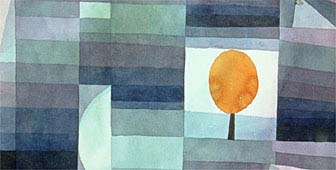Klee conquers London

An exhibition in London featuring the works of Switzerland's most original and influential modern artist, Paul Klee, is delighting art critics and visitors alike.
Entitled “The Nature of Creation”, the exhibition at the Hayward Gallery opened its doors on January 17 and is a collaboration between a number of organisations including Presence Switzerland, which promotes Switzerland abroad.
It brings together Klee’s work from private collections all over the world, much of which has never been displayed together. Paintings, watercolours and drawings adorn the walls of the gallery’s ground floor and mezzanine level.
Klee’s own perspective
The exhibition is curated by the Berlin-based art historian, Robert Kudielka, and artist Bridget Riley. The creative pair worked together to give the exhibition a unique flavour by examining Klee’s work from his own perspective.
“Instead of going back to the early works, the curators have taken 1914 as their starting point,” says Helen Luckett, the education programmer at the Hayward Gallery. “The paintings were produced after Klee had been to Tunisia. It was there that he felt he discovered himself as a painter. He said it was where he learnt to handle colour.”
“Colour has taken possession of me … I am a painter,” said Klee following the trip. With the help of his diaries, notebooks and lecture notes, the curators have examined what Klee intended to do with his art and what he felt he had already achieved.
With this in mind, the exhibition is divided into six sections, with each one focusing on a different development in Klee’s style and thinking between 1914 and his death in 1940. They start off with an area called “Square Paintings”, following through to the last section called “Disrupted Rhythms”.
Throughout the exhibition, Klee’s style meanders from simple line drawings to explosions of colour and back again, refusing to settle into any specific art movement.
“You can’t put him into a single movement,” muses Luckett. “Lots of movements picked up on what Klee was doing, for example the surrealists were very interested in Klee, but he wasn’t a surrealist. Likewise he wasn’t an expressionist.”
Hidden talents
The exhibition also draws attention to Klee’s hidden talents as a writer, musician and poet, with a full programme of “extra-curricular” events.
“There’s lots of things for adults and children,” Arwen Fitch, the gallery’s press co-ordinator told swissinfo. One highlight is certain to be “Poets in Conversation”, where Andrew Motion, the current poet laureate, and two others will discuss Klee’s translated poems.
For children and students there are a number of workshops, which will look at different aspects of Klee’s work.
Presence Switzerland
“The Nature of Creation” is also the launch event for Presence Switzerland’s 2002 UK programme, dubbed “Dialogue across Mountains”.
Although the exhibition was the brainchild of Bridget Riley, who approached the Hayward Gallery with the idea for a Klee showcase, the pro-Swiss body was happy to get involved.
“Presence Switzerland was more than keen to help out,” says Fitch, “as it was a wonderful opportunity to bring such a well known, yet almost neglected, artist to the public eye and launch the whole ‘Dialogue across Mountains’ programme.”
Presence Switzerland contributed to the project in two ways. Firstly it co-funded the publication of the exhibition’s catalogue, which has a foreword by the Swiss foreign minister, Joseph Deiss, and secondly it hosted a dinner to say thank you to the people who lent their Klee pictures to the exhibition.
Well received
“The Nature of Creation” has been well received by the London arts scene.
“The art critics are generally very positive,” says Luckett. “There are the odd few who say Klee isn’t exactly their artist, but I have been overwhelmed by the critics who say this is the most fantastic show and how beautifully it is hung here.”
The real proof of the pudding, however, lies in the number of visitors pouring through the Hayward’s doors each day. The gallery simply brims with amateur art groups, school trips and individual Klee enthusiasts, ranging from the very old to the very young.
“I think [the exhibition] is astonishing,” enthuses visitor Michael Parker. “I just find his pictures so beautiful. Unlike a lot of artists, I think the nearer you get to them, the more entrancing they become.”
A throng of schoolgirls in yellow and brown uniforms voice their praise by chirruping in unison: “It’s interesting – I really like the way he paints.”
“Paul Klee: The Nature of Creation” runs until April 1.
by Sally Mules

In compliance with the JTI standards
More: SWI swissinfo.ch certified by the Journalism Trust Initiative
You can find an overview of ongoing debates with our journalists here. Please join us!
If you want to start a conversation about a topic raised in this article or want to report factual errors, email us at english@swissinfo.ch.